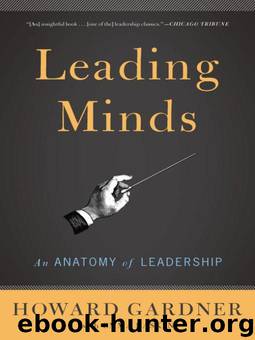Leading Minds: An Anatomy Of Leadership by Howard E. Gardner

Author:Howard E. Gardner [Gardner, Howard E.]
Language: eng
Format: mobi
ISBN: 9780465027774
Publisher: Basic Books
Published: 2011-12-05T14:00:00+00:00
Pope John XXIII was right to be concerned about the immediate fate of his legacy. Indeed, shortly after his death, he was called by one cardinal “the greatest disaster in recent ecclesiastical history—the last five hundred years.” He was followed in office by his chosen successor, Cardinal Giovanni Battista Montini—Pope Paul VI—who tried to carry on his work with respect to the internationalization of the church. Yet many of his more liberal tendencies in church practice and in interpretations of doctrine were allowed to become attenuated, both through the efforts of subsequent popes and through the naturally conservative instincts of church leaders throughout the world. Even the most inclusionary figures eventually generate opposition, usually from those who want to feel special; and not infrequently that opposition suffices to undo a progressive tendency.
The legacy of Pope John XXIII has proved most enduring through the messages embodied in his own person. Pope John showed the world that the leader of the church need not be austere, distant, and hieratic; he could feel genuine affinities to ordinary individuals, and this feeling could be reciprocated. He demonstrated that the leadership of the Catholic Church need not thwart affinity with other churches—nor even with atheistic communism. In so doing, he made a tangible contribution in forging closer ties among sects, peoples, and even warring superpowers.
Pope John’s simplicity was complete, pure, and eloquent. Ernesto Balducci wrote in The Utopia of Pope John XXIII that “the essential modernity of Pope John, which the world has grasped with immediate intuition, lay in the total sincerity with which he was able to accept the triumph of life, that of the child as well as that of the astronaut.” Just as first Angelo, and later John, attempted to revive the spirit of Christ, many of those inspired by him have sought to keep alive the spirit and the message of Pope John XXIII.
In this part of the book, I have examined prototypical leaders of three contemporary estates. I have surveyed a wide geographical area, from middle America to modern Rome to the global reaches of a world war—and a sizeable span of estates, from the American corporation, to the U.S. Army, to the largest religious establishment in the world. The three leaders all attained their positions gradually by dint of their achievements in a variety of “trial” postings and the increasing respect that their close colleagues held for them. As members of a hierarchical organization, they confronted authority figures when necessary, but not gratuitously. Once in high office, they had to determine and depict what it meant to lead their respective organizations at a rapidly changing moment in history. They each confirmed certain traditional norms and yet helped to redefine the nature of their institutions in their times. And while each was placed in a somewhat competitive state vis-à-vis others in their chosen estate, they strove for broader and more encompassing definitions of their particular realms.
Alfred Sloan, Jr., described what it meant to live in corporate America; George Marshall explained
Download
This site does not store any files on its server. We only index and link to content provided by other sites. Please contact the content providers to delete copyright contents if any and email us, we'll remove relevant links or contents immediately.
Rewire Your Anxious Brain by Catherine M. Pittman(18586)
Talking to Strangers by Malcolm Gladwell(13284)
The Art of Thinking Clearly by Rolf Dobelli(10312)
Mindhunter: Inside the FBI's Elite Serial Crime Unit by John E. Douglas & Mark Olshaker(9259)
Becoming Supernatural by Dr. Joe Dispenza(8159)
Change Your Questions, Change Your Life by Marilee Adams(7678)
Nudge - Improving Decisions about Health, Wealth, and Happiness by Thaler Sunstein(7654)
The Road Less Traveled by M. Scott Peck(7553)
The Lost Art of Listening by Michael P. Nichols(7452)
Mastermind: How to Think Like Sherlock Holmes by Maria Konnikova(7275)
Enlightenment Now: The Case for Reason, Science, Humanism, and Progress by Steven Pinker(7271)
Win Bigly by Scott Adams(7133)
The Way of Zen by Alan W. Watts(6547)
Daring Greatly by Brene Brown(6472)
Big Magic: Creative Living Beyond Fear by Elizabeth Gilbert(5675)
Grit by Angela Duckworth(5553)
Ego Is the Enemy by Ryan Holiday(5344)
Men In Love by Nancy Friday(5192)
The Laws of Human Nature by Robert Greene(5073)
